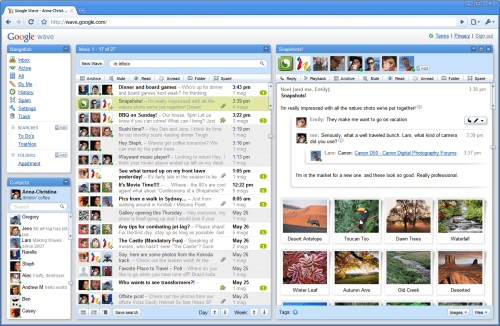One of the most ambitious efforts to come out of the Googleplex (or anywhere, really) in ages is Google Wave, a real-time messaging, sharing, and collaborating service unveiled last week. Finally, Google’s crack at the Real-Time Web. We’ve been waiting.
Google’s Real-Time Web
You might recall ReadWriteWeb proclaiming the big G missed the boat on that, as Twitter rules over real-time search these days. However, Wave makes one realize there is more to the real-time web than 140-character messages.
It’s a new way of doing things. It’s decentralized, open-source, and poised to take over online communications the way email has, since it’s built as a fundamental protocol. But it’s not even just “the new email”, it lets you do a lot more than that. It was built to service needs knowing the capabilities of the Web today:
Ezra Pound once wrote: “”The artist is always beginning. Any work of art which is not a beginning, an invention, a discovery is of little worth.” And elsewhere: “Make it new!”
Even more than the application itself, I love the way Wave doesn’t just build on what went before but starts over. In demonstrating the power of the shared, real-time information space, Jens and Lars show a keen understanding of how the cloud changes applications.
When I saw Wave for the first time on Monday, I realized that we’re at a kind of DOS/Windows divide in the era of cloud applications. Suddenly, familiar applications look as old-fashioned as DOS applications looked as the GUI era took flight. Now that the web is the platform, it’s time to take another look at every application we use today, and ask the same question Lars and Jens asked themselves: “What would this look like if we invented it today instead of twenty-five years ago?”
This is not another reboot of the social network format the way Google redid email with Gmail and redid search with Google Search. But it does feel this is the way social interactions on the Web were supposed to be. Aren’t you tired of signing up over and over for the hottest new web service, OpenID/etc. not withstanding?
I love the diversity and downright chaos of the Internet, but the future has got to be seamless integration between all things. Text, photos, videos, blog posts, polls, calendars, petitions, lyrics, jokes, LOLcats, whatever.
Now when Google says real-time, it means your friend’s message appears on your screen by the character, instead of a “your friend is typing…” notice as you twiddle your thumbs. It also means you can reply to any part of your friend’s message, edit any part of a document, and replay exactly how everything happened when you’re done. See video above. It’s brilliant.
Terrifying ramifications?
That’s barely scratching the surface. I’m not sure if the protocol will succeed—not everybody lives in real-time online, or can handle this many features (see Twitter).
If it does succeed, it might become too successful that users are addicted, possibly trapped in this real-time space. We continue to blur the line between the real and the virtual, and even if at this point we can tell the difference between the two, will we ever reach the point of being “too” connected, transparent, hyperreal?
I’m not even sure if we should be trust yet another invention from Google—there has to be something in it for them, right?
Are you terrified yet? I think I am, but I’m pretty excited too.
Originally posted on May 31, 2009 @ 4:00 am
